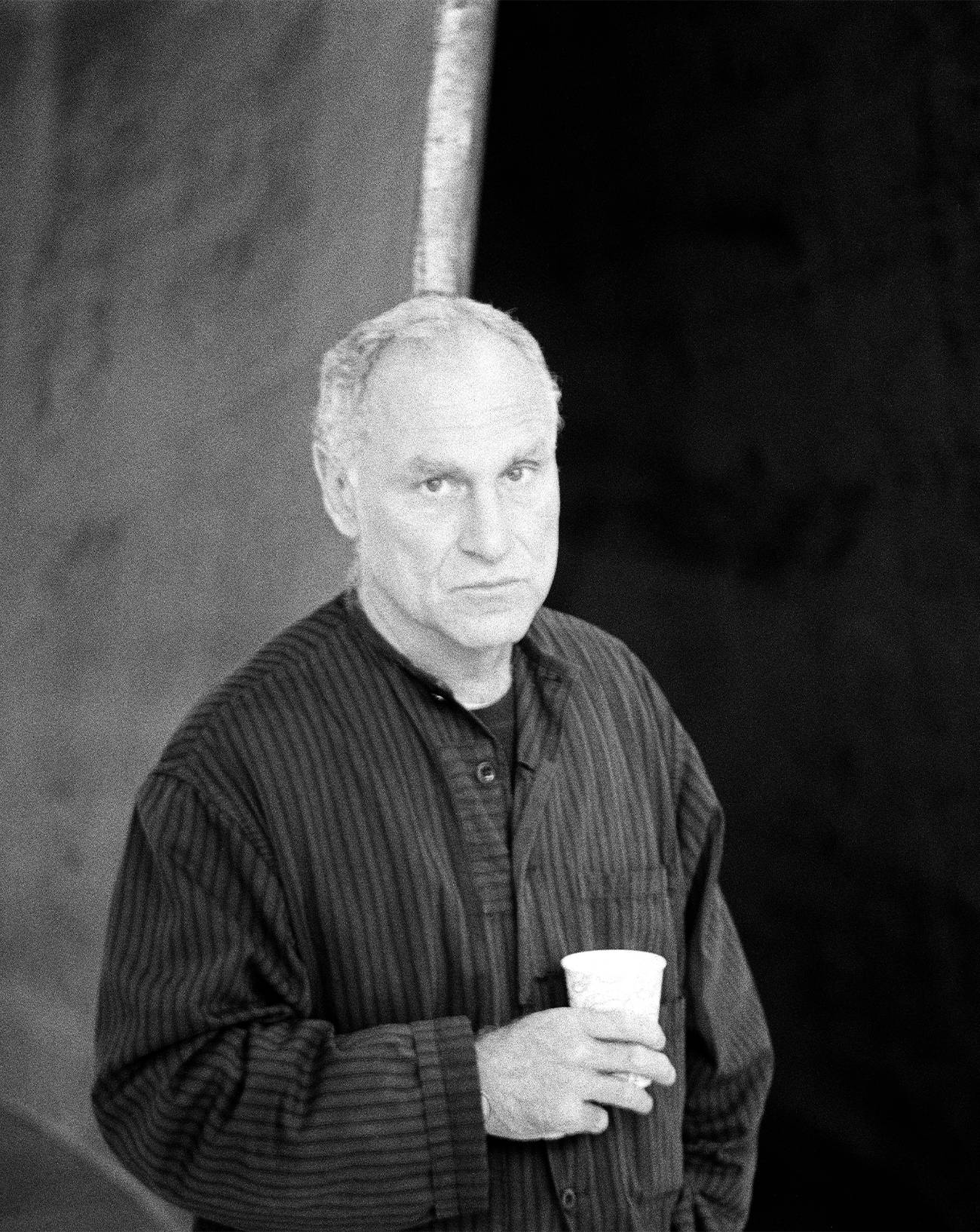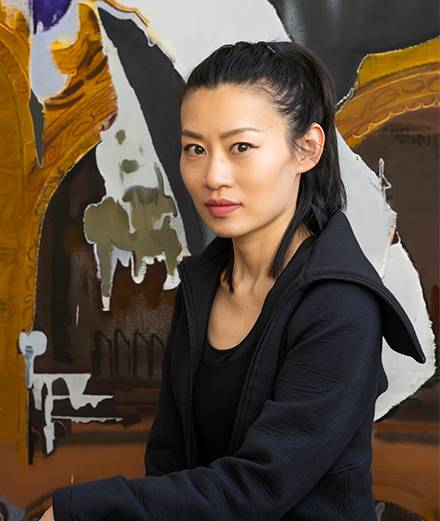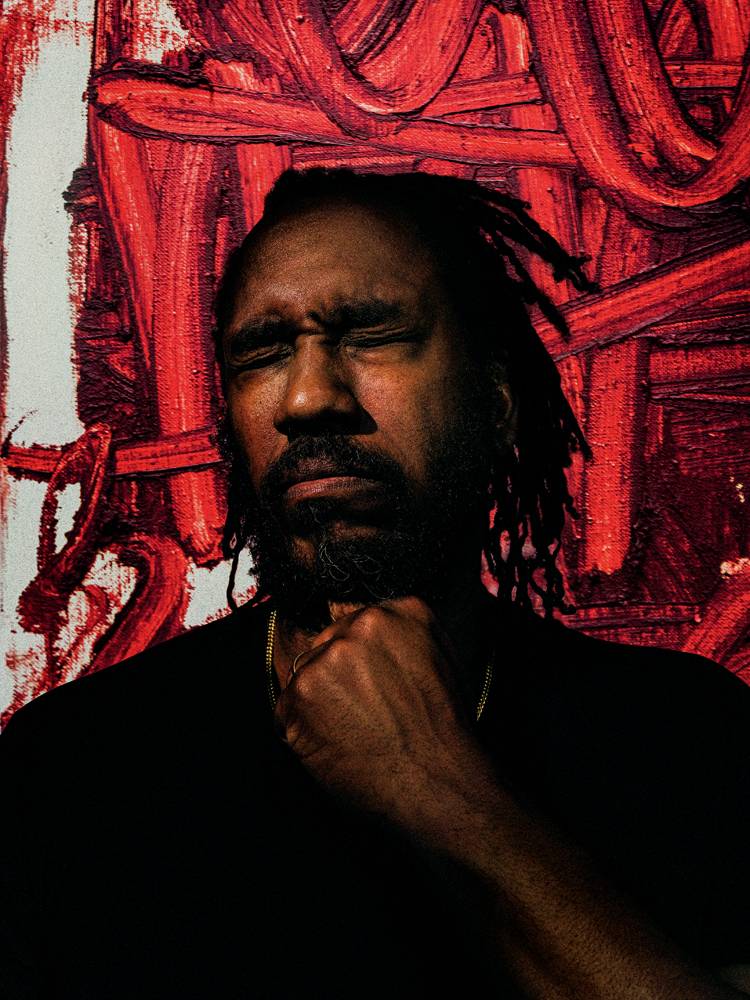Otherworldly is an adjective that could easily sum up Jennifer Guidi’s artworks. A word that manages to gather two major aspects of her practice : otherness, which we find in her landscapes escaping a faithful depiction of reality, and world, which emerges in her cosmological imaginary diving into the pits of the infinite. In this artist’s paintings, we can identify immense skies filled with light, full circles that remind us of both sun and moon, triangles which could stand for sacred mountains or giant snakes with their sinuous silhouettes. Through these numerous symbols, Guidi dives her works into mysticism and contemplation, which she enhances through clean lines and shapes, plus her use of vivid and deep colors. After a rather classical course in figurative painting, the young woman found her signature material 15 years ago : sand, which she started to melt with oil painting to add textures to her works.
With time, Jennifer Guidi has perfected her technique by digging holes into the sand to create mandalas, a very recognizable pattern that has aroused American collectors’ interest before attracting people from every part of the world. Despite being represented by three major contemporary art galleries, like David Kordansky and Gagosian, the artist has merely exhibited in France, until Italian gallerist Massimo De Carlo recently organized her first solo show inside his new space in Paris called ‘Pièce Unique’. Thanks to Guidi’s magic, this white and luminous small space has suddenly turned into a night sky, covered from ground to ceiling in a dark blue wallpaper where the painter showcases a glowing red sunset painting and a turquoise rock studded with holes – her first sculpture unveiled to the public. In light of this exciting project, we met with the artist on Zoom, in her Californian house, bathed in the same shining light than we can feel, standing in front of her meditative works.
Numéro : You have started using sand around in the 2000, looking to add more texture to your works. Then you added those little holes in it. How did you master that technique?
Jennifer Guidi : Before I started making paintings with sand, it was just popping in my mind for some reason. I was attracted to any painting I saw that had sand in it, whether it was by Picasso, Dubuffet… Even being at the beach, I was drawing into the sand and poking holes into it, wondering how I could translate that onto the canvas and make it stay as a permanent material. So first, I would mix it up in oil paint and put it on my painting to get that effect. It took probably a year of fixing different things together, making different types of marks, then couple of years of finding my own patterns, which were at times more random and organic, and other times more precise and repetitive. When those experiments met with the symbols I already used in my paintings, there was an “aha” moment : it connected with what I wanted to put out there, and I was finally able to use that technique as an armature to which I added different layers. In my studio, I had it one way for a very long time and then added another layer of these dots on top, which opened it up and created more vibration. There is something very exciting for me playing with the colors on top, that keep on creating this vibration and optical effect.
As your sand painting technique was inspired by a trip to Marrakech, it seems like traveling gives you quite some inspiration for your works. How was it to stay inspired since last year?
That is a good question. It has been so rare for me to be stuck so long at my home in Los Angeles! In the studio, it was a time where I really archived my work, organized things in a certain way, looked back at photos of the previous trips I had made. I was really looking at pieces of things that I loved and wanted to bring into new works more. I also feel like my meditation practice is very linked to my art practice : that is a time where I get a lot of ideas. I do really believe in traveling inward, where everything that we need and all of our ideas reside. When we really connect to that and give ourselves the time to really sit and think, there are so many ideas and possibilities… Lockdown really was the time to devote myself to this inner travel.


Do you happen to get tired of your technique, or to find it repetitive ?
My works are made of repetition, but despite this repetitiveness, which I enjoy, there is always something slightly new happening. I have two main types of paintings : one I call the “sand mandalas”, where the sand is thick and I dig the holes into it, and the “universe mandalas”, which start with a smooth sand ground on top of which I paint the mandala. Right now I’m playing with all these different backgrounds where I put some marks on, for a new set of paintings. Playing with color and creating atmospheres is very exciting.
Do the settings of Los Angeles and California feed your works?
They definitely do. In Los Angeles we are surrounded by mountains, which I see everyday when I drive to my studio. The light here is very important and special, especially that of the sunrises and sunsets, which are so beautiful. It’s something that I try to really take in on a daily basis. I really notice it during the winter months, where a very particular light and shadow is cast on buildings and mountains. Los Angeles is also an interesting place because there is this connection to the urban world that I really need: I love the pulse of the city, and this energy is very important for creating artwork. But at the same time, right up the streets you can go walk trails in Griffith Park. I really like this duality here.
“I really believe in traveling inward, where everything we need and all of our ideas reside.”
Your works contain recurring symbols : snakes, moons, pyramids… Are their particular references there ?
I definitely look at earlier civilisations : Ancient Egypt and pyramids, even Celtic symbolism are very interesting to me. I’m just so curious, I wish I could go back in time to really see how these things were living in their time. I like the idea that, during those times, art was so linked with life and people used pictures a lot to communicate with each other. Even in Italy or in France, when you are walking around you see religious symbols everywhere : the trinity, snakes intertwined, all of those things really catch my eyes. In my work especially, the snake is about transformation, creativity, rebirth by shedding his skin, but also the symbol of medicine and healing.


The esoteric and spiritual references are very obvious in your work, while interest for esoteric sciences such as astrology, Wicca witchcraft and tarot-reading has definitely been rising over the past decade. Do you think your own inspirations are part of a broader phenomenon?
For a long time, I was painting with the feeling I wasn't making what I wanted to. I believe in this idea of asking the universe what we are supposed to do, and answers to that came from my meditation practice. Most people that meditate have told me the same: you connect to something that is otherworldly. I’m not saying I believe in witchcraft, but I do believe in a spiritual world, and I feel like if we’re open to it we will be able to connect to it. As artists, we have that intuition that move us towards different directions, whether it’s inside our soul or around us. More generally, we are so disconnected to our environment now, and a lot of it comes from how connected we are to our screens in ways we never were before. When people want to become more grounded with nature, try to make time to get out of that… There’s amazing things about our phones, technologies and social media : it’s opened up so much of the world for all of us, but it also keeps us very detached from connecting with ourselves or our friends in a genuine way.
Recently, an artist did tell me that the word “abstract” has often been misused. Would you qualify your work as abstract?
I would. I started as a figurative painter and the way I learned to paint was very traditional. When I did paint representational paintings, and it was just about recording things around me and make it seem as real as possible, it didn’t feel like it was me. It took me a long time to really have the confidence to make an abstract painting and strip it down to colors and textures. There was always a part of me that felt like : what does it mean if there is no image there? Sometimes, I like to put a little of my figurative history back in my work, but still maintaining that freedom to go wherever I want to.
Your installation for David Kordansky Gallery during the latest physical FIAC, in 2019, was very original. You showcased a series of small drawings inside a black arena, thus completely immersing the visitor in your art. Why is the physical display so important to you?
How and where my works are displayed influences how visitors and I are going to feel. For FIAC, when David Kordansky asked me to do a solo drawing show, I first said no : all I could picture was my small drawings in a white square, where no one would spend time with them in the way I wanted to. As I kept thinking how I could create a space within a fair, where the visitors would be walking from one white cube to the other, the idea of creating this arena for them popped in my mind, coming out of this will to create a new environment. That is the same with my new Parisian show. I don’t want to just put one piece on the wall and have people walk by, I want people to experience art in a certain type of environment.


Being used to show several works at the same time, how was it to focus on only one work for this show at Massimo de Carlo Pièce Unique, which is the gallery's principle in Paris?
I didn’t do exactly that (laughs). When Massimo got the space, I got really excited about it, just looking at the pictures and history. It was a place I immediately wanted to do something in. But I wanted to use it to make an installation, which I ended up doing. I thought of the whole space as a cube and I created a wallpaper, where I am showing a painting and, for the first time, a sculpture. I am thinking of these three elements as one piece, or one same world. At the beginning of the pandemic, I created a sandgarden in my studio, and out of this came these rock sculptures. I treated them in a similar way to my paintings : they are bronze pieces, but before I cast them I built them with rocks, added sands on top of them and made holes into it. I feel like it’s taking a painting and transforming it into a three-dimensional object.
Your painting practice is already very three-dimensional, which is why I’m surprised you only started sculpture recently…
Sculpture is definitely something I’ve been thinking about for a long time, but it's difficult. I just didn’t want to put anything out there, so it’s been a slow process, making things that haven’t made sense and worked yet. Sculpture for me has been more experimental while I was more comfortable with my paintings and the idea of putting something on the wall. Presenting an artwork on the floor or on a pedestal is an interesting process that I definitely was able to play with in a more organic way during quarantine. Making this zen garden in my studio, filling it with rocks was like building new ideas. It’s a direction I would like to push in terms of outdoor and very large sculptures. So the one sculpture I was showing in the Paris exhibition is my first attempt at putting it out in the world.
“I think of all my paintings as energy sources, with the idea of vibration.”
Are the three pieces linked by a common theme or idea?
The whole installation is entitled Points of harmony. I’m playing with this idea of the number 3, which I already used in my triangular paintings. The common ideas are always things that I think about, points in time or in my life, my meditation practice… In this installation, the painting is called Sungazing as I recently met this artist with whom we talked about how looking at the sun to generate energy in your body. I think of all my paintings as energy sources, with the idea of vibration. When you stand in front of them you do have a physical experience with them, because of the optical effect. In the wallpaper I created for Massimo De Carlo, I zoomed in on one of my painting : when you see it in the gallery's space, it looks like the night sky with stars. Space, universe, sun, mountains and the earth are definitely the grounding elements in my work.
Do you see your artistic practice as meditative?
I do. I think when I really tap into it, creating and working, it feels like I’m in a very akin place to a meditative process. Maybe working in a very repetitive way, making those movements and those marks allows my brain to slip off of this area where I could be thinking about something else, other works, other ideas. In my art, everything is coming out of this desire to create something that keeps going over and over in my mind until it’s in front of my eyes.



















